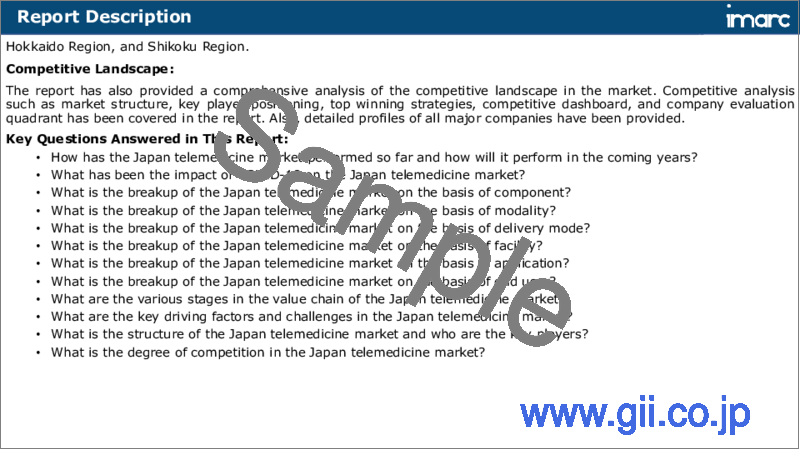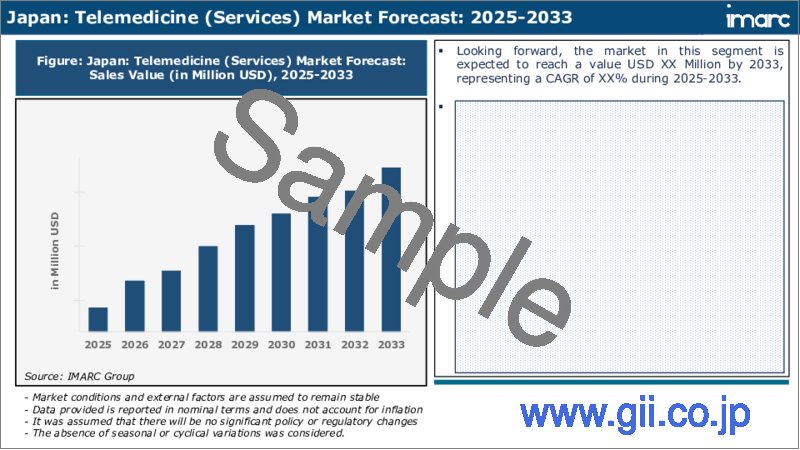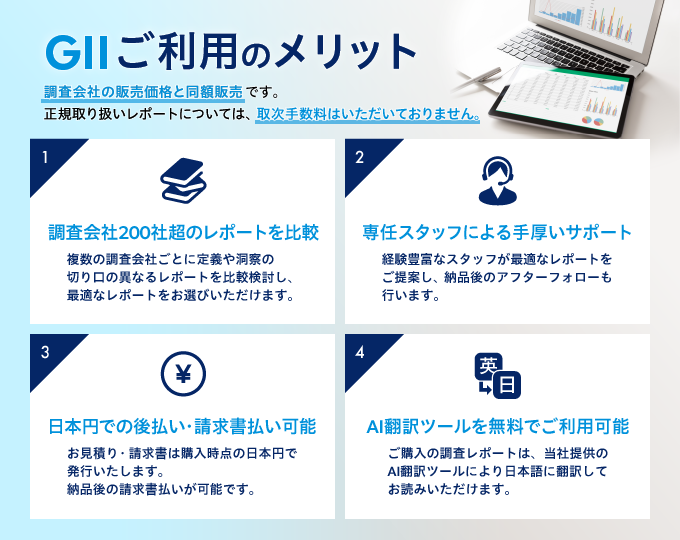|
|
市場調査レポート
商品コード
1609684
日本の遠隔医療市場レポート:コンポーネント、通信技術、ホスティングタイプ、用途、エンドユーザー、地域別、2025年~2033年Japan Telehealth Market Report by Component, Communication Technology, Hosting Type, Application, End User, and Region 2025-2033 |
||||||
カスタマイズ可能
|
|||||||
| 日本の遠隔医療市場レポート:コンポーネント、通信技術、ホスティングタイプ、用途、エンドユーザー、地域別、2025年~2033年 |
|
出版日: 2024年12月05日
発行: IMARC
ページ情報: 英文 120 Pages
納期: 5~7営業日
|
全表示
- 概要
- 目次
日本の遠隔医療市場の市場規模は2024年に14億米ドルに達しました。IMARC Groupは、2025年から2033年にかけての成長率(CAGR)は20.3%で、2033年には72億米ドルに達すると予測しています。地方や遠隔地における便利で利用しやすいヘルスケアサービスに対する需要の高まり、慢性疾患の有病率の増加と継続的な医療モニタリングに対するニーズの高まり、カスタマイズされたヘルスケアソリューションに対する需要の高まりなどが、市場を牽引する主な要因となっています。
本レポートで扱う主な質問
- 日本の遠隔医療市場はこれまでどのように推移し、今後どのように推移するのか?
- COVID-19が日本の遠隔医療市場に与えた影響は?
- 日本の遠隔医療市場のコンポーネント別の内訳は?
- 日本の遠隔医療市場の通信技術別の内訳は?
- 日本の遠隔医療市場のホスティングタイプ別の内訳は?
- 日本の遠隔医療市場の用途別内訳は?
- 日本の遠隔医療市場のエンドユーザー別の内訳は?
- 日本の遠隔医療市場のバリューチェーンにはどのような段階がありますか?
- 日本の遠隔医療市場の主な促進要因と課題は何か?
- 日本の遠隔医療市場の構造と主要プレーヤーは?
- 日本の遠隔医療市場の競合の程度は?
目次
第1章 序文
第2章 調査範囲と調査手法
- 調査の目的
- ステークホルダー
- データソース
- 市場推定
- 調査手法
第3章 エグゼクティブサマリー
第4章 日本の遠隔医療市場:イントロダクション
- 概要
- 市場力学
- 業界動向
- 競合情報
第5章 日本の遠隔医療市場情勢
- 過去および現在の市場動向(2019年~2024年)
- 市場予測(2025-2033)
第6章 日本の遠隔医療市場:コンポーネント別の内訳
- ソフトウェア
- ハードウェア
- サービス
第7章 日本の遠隔医療市場:通信技術別の内訳
- ビデオ会議
- mヘルスソリューション
- その他
第8章 日本の遠隔医療市場:ホスティングタイプ別の内訳
- クラウドベースとウェブベース
- オンプレミス
第9章 日本の遠隔医療市場:用途別の内訳
- 遠隔コンサルティングと遠隔指導
- 医療教育と研修
- 遠隔放射線診断
- 遠隔心臓病学
- 遠隔ICU
- テレサイキアトリー
- 遠隔皮膚科
- その他
第10章 日本の遠隔医療市場:エンドユーザー別の内訳
- プロバイダー
- 患者
- 支払者
- その他
第11章 日本の遠隔医療市場:競合情勢
- 概要
- 市場構造
- 市場プレーヤーのポジショニング
- 主要成功戦略
- 競合ダッシュボード
- 企業評価象限
第12章 主要企業のプロファイル
第13章 日本の遠隔医療市場:業界分析
- 促進要因・抑制要因・機会
- ポーターのファイブフォース分析
- バリューチェーン分析
第14章 付録
The Japan telehealth market size reached USD 1.4 Billion in 2024. Looking forward, IMARC Group expects the market to reach USD 7.2 Billion by 2033, exhibiting a growth rate (CAGR) of 20.3% during 2025-2033. The growing demand for convenient and accessible healthcare services in rural and remote areas, increasing prevalence of chronic diseases and rising need for continuous medical monitoring, and escalating demand for customized healthcare solutions represent some of the key factors driving the market.
Telehealth refers to the employment of telecommunications technologies, such as video conferencing, mobile applications, and remote monitoring devices, to provide healthcare services remotely. It comprises real-time telehealth, store-and-forward telehealth, and remote patient monitoring, which encompasses the usage of wearable systems and sensors to collect and transmit patient data to healthcare providers. It enables patients to access medical consultations and services from the comfort of their residence, reducing travel time and associated expenses. It allows healthcare professionals to diagnose, treat, and monitor patients from a distance, overcoming geographical barriers and increasing the reach of healthcare services. It also facilitates the exchange of medical information between healthcare providers, improving collaboration and continuity of care. It can provide patients with access to educational resources and information, empowering them to better manage their health and make informed decisions. Telehealth leads to cost savings for both patients and healthcare providers, as it minimizes the need for physical infrastructure and streamlines healthcare operations. It also allows healthcare providers to electronically prescribe medications, enhancing convenience for patients and reducing prescription errors. As telehealth plays a critical role in providing healthcare services during emergencies, natural disasters, or public health crises, ensuring continuity of care even in challenging circumstances, its demand is rising in Japan.
Japan Telehealth Market Trends:
At present, the increasing adoption of digital health technologies and advancements in telecommunication infrastructure represents one of the major factors influencing the market positively in Japan. Moreover, the rising demand for convenient and accessible healthcare services in numerous rural and remote areas is strengthening the growth of the market in Japan. Apart from this, the growing occurrence of chronic diseases, along with the escalating demand for continuous medical monitoring and management, is offering a positive market outlook. Additionally, the rising employment of telehealth services for reducing the burden on traditional healthcare facilities by enabling remote patient monitoring and virtual consultations is offering lucrative growth opportunities to industry investors in Japan. In line with this, increasing investments in telehealth startups and innovative technologies are impelling the market growth. Besides this, rising collaborations between healthcare providers, technology companies, and investors for the development of new telehealth applications and platforms, enhancing the overall quality and accessibility of telemedicine services, are propelling the growth of the market in the country. In addition, the rising focus on strengthening the security of telehealth platforms is bolstering the growth of the market. Furthermore, the increasing demand for customized healthcare solutions and personalized medications and therapy is contributing to the market growth in Japan.
Japan Telehealth Market Segmentation:
Component Insights:
- Software
- Hardware
- Service
Communication Technology Insights:
- Video Conferencing
- mHealth Solutions
- Others
Hosting Type Insights:
- Cloud-Based and Web-Based
- On-Premises
Application Insights:
- Teleconsultation and Telementoring
- Medial Education and Training
- Teleradiology
- Telecardiology
- Tele-ICU
- Tele-Psychiatry
- Tele-Dermatology
- Others
End User Insights:
- Providers
- Patients
- Payers
- Others
Competitive Landscape:
- The report has also provided a comprehensive analysis of the competitive landscape in the market. Competitive analysis such as market structure, key player positioning, top winning strategies, competitive dashboard, and company evaluation quadrant has been covered in the report. Also, detailed profiles of all major companies have been provided.
Key Questions Answered in This Report:
- How has the Japan telehealth market performed so far and how will it perform in the coming years?
- What has been the impact of COVID-19 on the Japan telehealth market?
- What is the breakup of the Japan telehealth market on the basis of component?
- What is the breakup of the Japan telehealth market on the basis of communication technology?
- What is the breakup of the Japan telehealth market on the basis of hosting type?
- What is the breakup of the Japan telehealth market on the basis of application?
- What is the breakup of the Japan telehealth market on the basis of end user?
- What are the various stages in the value chain of the Japan telehealth market?
- What are the key driving factors and challenges in the Japan telehealth market?
- What is the structure of the Japan telehealth market and who are the key players?
- What is the degree of competition in the Japan telehealth market?
Table of Contents
1 Preface
2 Scope and Methodology
- 2.1 Objectives of the Study
- 2.2 Stakeholders
- 2.3 Data Sources
- 2.3.1 Primary Sources
- 2.3.2 Secondary Sources
- 2.4 Market Estimation
- 2.4.1 Bottom-Up Approach
- 2.4.2 Top-Down Approach
- 2.5 Forecasting Methodology
3 Executive Summary
4 Japan Telehealth Market - Introduction
- 4.1 Overview
- 4.2 Market Dynamics
- 4.3 Industry Trends
- 4.4 Competitive Intelligence
5 Japan Telehealth Market Landscape
- 5.1 Historical and Current Market Trends (2019-2024)
- 5.2 Market Forecast (2025-2033)
6 Japan Telehealth Market - Breakup by Component
- 6.1 Software
- 6.1.1 Overview
- 6.1.2 Historical and Current Market Trends (2019-2024)
- 6.1.3 Market Forecast (2025-2033)
- 6.2 Hardware
- 6.2.1 Overview
- 6.2.2 Historical and Current Market Trends (2019-2024)
- 6.2.3 Market Forecast (2025-2033)
- 6.3 Service
- 6.3.1 Overview
- 6.3.2 Historical and Current Market Trends (2019-2024)
- 6.3.3 Market Forecast (2025-2033)
7 Japan Telehealth Market - Breakup by Communication Technology
- 7.1 Video Conferencing
- 7.1.1 Overview
- 7.1.2 Historical and Current Market Trends (2019-2024)
- 7.1.3 Market Forecast (2025-2033)
- 7.2 mHealth Solutions
- 7.2.1 Overview
- 7.2.2 Historical and Current Market Trends (2019-2024)
- 7.2.3 Market Forecast (2025-2033)
- 7.3 Others
- 7.3.1 Historical and Current Market Trends (2019-2024)
- 7.3.2 Market Forecast (2025-2033)
8 Japan Telehealth Market - Breakup by Hosting Type
- 8.1 Cloud-Based and Web-Based
- 8.1.1 Overview
- 8.1.2 Historical and Current Market Trends (2019-2024)
- 8.1.3 Market Forecast (2025-2033)
- 8.2 On-Premises
- 8.2.1 Overview
- 8.2.2 Historical and Current Market Trends (2019-2024)
- 8.2.3 Market Forecast (2025-2033)
9 Japan Telehealth Market - Breakup by Application
- 9.1 Teleconsultation and Telementoring
- 9.1.1 Overview
- 9.1.2 Historical and Current Market Trends (2019-2024)
- 9.1.3 Market Forecast (2025-2033)
- 9.2 Medial Education and Training
- 9.2.1 Overview
- 9.2.2 Historical and Current Market Trends (2019-2024)
- 9.2.3 Market Forecast (2025-2033)
- 9.3 Teleradiology
- 9.3.1 Overview
- 9.3.2 Historical and Current Market Trends (2019-2024)
- 9.3.3 Market Forecast (2025-2033)
- 9.4 Telecardiology
- 9.4.1 Overview
- 9.4.2 Historical and Current Market Trends (2019-2024)
- 9.4.3 Market Forecast (2025-2033)
- 9.5 Tele-ICU
- 9.5.1 Overview
- 9.5.2 Historical and Current Market Trends (2019-2024)
- 9.5.3 Market Forecast (2025-2033)
- 9.6 Tele-Psychiatry
- 9.6.1 Overview
- 9.6.2 Historical and Current Market Trends (2019-2024)
- 9.6.3 Market Forecast (2025-2033)
- 9.7 Tele-Dermatology
- 9.7.1 Overview
- 9.7.2 Historical and Current Market Trends (2019-2024)
- 9.7.3 Market Forecast (2025-2033)
- 9.8 Others
- 9.8.1 Historical and Current Market Trends (2019-2024)
- 9.8.2 Market Forecast (2025-2033)
10 Japan Telehealth Market - Breakup by End User
- 10.1 Providers
- 10.1.1 Overview
- 10.1.2 Historical and Current Market Trends (2019-2024)
- 10.1.3 Market Forecast (2025-2033)
- 10.2 Patients
- 10.2.1 Overview
- 10.2.2 Historical and Current Market Trends (2019-2024)
- 10.2.3 Market Forecast (2025-2033)
- 10.3 Payers
- 10.3.1 Overview
- 10.3.2 Historical and Current Market Trends (2019-2024)
- 10.3.3 Market Forecast (2025-2033)
- 10.4 Others
- 10.4.1 Overview
- 10.4.2 Historical and Current Market Trends (2019-2024)
- 10.4.3 Market Forecast (2025-2033)
11 Japan Telehealth Market - Competitive Landscape
- 11.1 Overview
- 11.2 Market Structure
- 11.3 Market Player Positioning
- 11.4 Top Winning Strategies
- 11.5 Competitive Dashboard
- 11.6 Company Evaluation Quadrant
12 Profiles of Key Players
- 12.1 Company A
- 12.1.1 Business Overview
- 12.1.2 Product Portfolio
- 12.1.3 Business Strategies
- 12.1.4 SWOT Analysis
- 12.1.5 Major News and Events
- 12.2 Company B
- 12.2.1 Business Overview
- 12.2.2 Product Portfolio
- 12.2.3 Business Strategies
- 12.2.4 SWOT Analysis
- 12.2.5 Major News and Events
- 12.3 Company C
- 12.3.1 Business Overview
- 12.3.2 Product Portfolio
- 12.3.3 Business Strategies
- 12.3.4 SWOT Analysis
- 12.3.5 Major News and Events
- 12.4 Company D
- 12.4.1 Business Overview
- 12.4.2 Product Portfolio
- 12.4.3 Business Strategies
- 12.4.4 SWOT Analysis
- 12.4.5 Major News and Events
- 12.5 Company E
- 12.5.1 Business Overview
- 12.5.2 Product Portfolio
- 12.5.3 Business Strategies
- 12.5.4 SWOT Analysis
- 12.5.5 Major News and Events
13 Japan Telehealth Market - Industry Analysis
- 13.1 Drivers, Restraints, and Opportunities
- 13.1.1 Overview
- 13.1.2 Drivers
- 13.1.3 Restraints
- 13.1.4 Opportunities
- 13.2 Porters Five Forces Analysis
- 13.2.1 Overview
- 13.2.2 Bargaining Power of Buyers
- 13.2.3 Bargaining Power of Suppliers
- 13.2.4 Degree of Competition
- 13.2.5 Threat of New Entrants
- 13.2.6 Threat of Substitutes
- 13.3 Value Chain Analysis





